Forgotten Realms is a campaign setting for the Dungeons & Dragons (D&D) fantasy role-playing game. Commonly referred to by players and game designers as "The Realms", it was created by game designer Ed Greenwood around 1967 as a setting for his childhood stories. Several years later, it was published for the D&D game as a series of magazine articles, and the first Realms game products were released in 1987. Role-playing game products have been produced for the setting ever since, in addition to novels, role-playing video game adaptations, comic books, and the film Dungeons & Dragons: Honor Among Thieves.
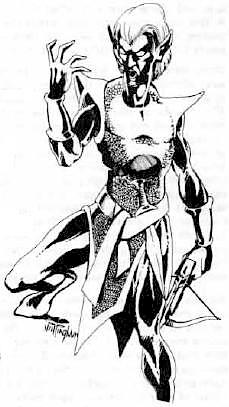
The drow or dark elves are a dark-skinned and white-haired subrace of elves connected to the subterranean Underdark in the Dungeons & Dragons fantasy roleplaying game. The drow have traditionally been portrayed as generally evil and connected to the evil spider goddess Lolth. However, later editions of Dungeons & Dragons have moved away from this portrayal and preassigned alignment. More recent publications have explored drow societies unconnected to Lolth.

Vecna is a fictional character appearing in the Dungeons & Dragons fantasy role-playing game. Vecna has been named one of the greatest villains in the Dungeons & Dragons franchise.
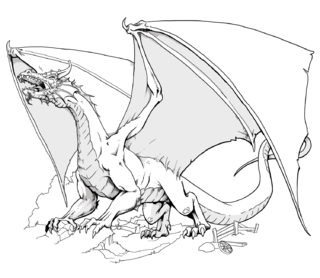
In the Dungeons & Dragons (D&D) fantasy role-playing game, dragons are an iconic type of monstrous creature. As a group, D&D dragons are loosely based on dragons from a wide range of fictional and mythological sources. Dungeons & Dragons allows players to fight the fictional dragons in the game and "slay their psychic dragons" as well. These dragons, specifically their "dungeon ecology", have implications for the literary theory of fantasy writing. D&D dragons also featured as targets of the moral panic surrounding the game.
In the fantasy role-playing game Dungeons & Dragons, an Outer Plane is one of a number of general types of planes of existence. They can also be referred to as godly planes, spiritual planes, or divine planes. The Outer Planes are home to beings such as deities and their servants such as demons, celestials and devils. Each Outer Plane is usually the physical manifestation of a particular moral and ethical alignment and the entities that dwell there often embody the traits related to that alignment.
A devil is a fictional classification of monsters in the Dungeons & Dragons roleplaying game. Often used as a high-level challenge for players of the game, devils are Lawful Evil in alignment and originate from the Nine Hells of Baator. In accordance with their Lawful Evil alignment, devils adhere to a rigid and ruthless hierarchy, undergoing transformations as they ascend the power structure. At the pinnacle of this hierarchy stand the mighty Archdevils, also known as the Lords of the Nine, who exercise dominion over distinct realms within Baator. Devils frequently view the myriad worlds in the D&D metacosmos as instruments to be manipulated for their own purposes, including waging the Blood War—a centuries-long conflict against their arch-foes, the demons.

Takhisis is a fictional character from the Dragonlance universe. She is depicted as the main goddess of evil in the setting and head of the Dark Pantheon.
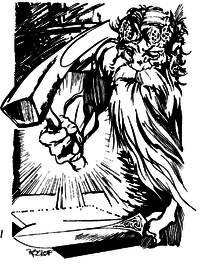
Moradin is the chief deity in the dwarven pantheon in the Dungeons & Dragons game and is a member of the default D&D pantheon. In 3rd edition, Moradin's domains are Creation, Earth, Good, Law, and Protection. The 5th Edition Players Handbook include Knowledge as a suggested domain. His titles include Soul Forger, Dwarffather, the All-Father, and the Creator. He created the first dwarves out of earthen materials and tutored them in dwarven ways.

James Wyatt is a game designer and a former United Methodist minister. He works for Wizards of the Coast, where he has designed supplements and adventures for the Dungeons & Dragons (D&D) roleplaying game. He is the author of sci-fi and fantasy novels, including Forgotten Realms books, and the 4th edition Dungeon Master's Guide.
In the Dungeons & Dragons fantasy roleplaying game, Tharizdun is the god of Eternal Darkness, Decay, Entropy, Malign Knowledge, Insanity, and Cold. He originated in the World of Greyhawk campaign setting but has since also appeared in other settings.

In the Dungeons & Dragons fantasy role-playing game, goblins are a common and fairly weak race of evil humanoid monsters. Goblins are non-human monsters that low-level player characters often face in combat.

In the Dungeons & Dragons (D&D) role-playing game, Bahamut is a powerful draconic deity, who has the same name as Bahamut from Arabic mythology.

The Draconomicon is the title for several optional sourcebooks for the Dungeons & Dragons role-playing game, providing supplementary game mechanics for dragons specifically. Different Draconomicon books have been issued for the 2nd, 3rd, and 4th editions of the Dungeons & Dragons game. The Latin-inspired name of the books loosely translates as "Book of Dragon Names".

The lich is an undead creature found in the Dungeons & Dragons (D&D) fantasy role-playing game. Liches are spellcasters who seek to defy death by magical means.

Fantastic Locations: Dragondown Grotto is a generic setting adventure module for the 3.5 edition of the Dungeons & Dragons roleplaying game. The adventure is designed for 10th level characters. It contains a 16-page adventure as well as two poster sized double-sided maps for use in miniatures play.
The Wand of Orcus is a fictional magical weapon described in various Dungeons & Dragons media. Because of the popularity of Orcus as a villain within the Dungeons & Dragons universe, many different authors have written materials describing artifacts created by or associated with the character. The Wand of Orcus is consistently the most important and most described of these artifacts. Screen Rant has noted that "[t]he weapon that Orcus wields in battle is almost as famous as the demon lord himself". Furthermore, the device has at times been employed in books, games, and other media within the franchise as a thing distinct from Orcus himself, such that adventurers may encounter the wand as a freestanding element of the game or story.

In the Dungeons & Dragons role-playing game, Corellon Larethian is the leader of the elven pantheon, and the deity of Magic, Music, Arts, Crafts, Poetry, and Warfare. Corellon is also considered a member of the default D&D pantheon. Corellon is the creator and preserver of the elven race, and governs those things held in the highest esteem among elves. Corellon's symbol was originally a crescent moon; in the 4th edition Corellon's symbol is a silver star on a blue field.
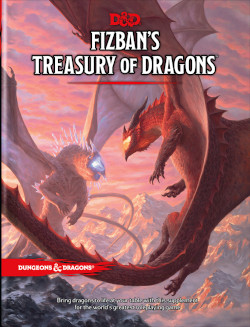
Fizban's Treasury of Dragons is sourcebook that focuses on dragons in the 5th edition of the Dungeons & Dragons fantasy role-playing game and was published October 26, 2021. The book adds a variety of draconic themed options for both players and Dungeon Masters.
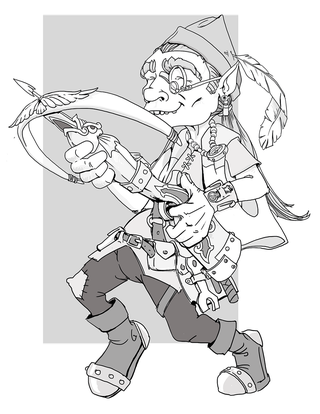
In the Dungeons & Dragons fantasy role-playing game, gnomes are one of the core races available for play as player characters. Some speculate that they are closely related to dwarves; however, gnomes are smaller and more tolerant of other races, nature, and magic. Depending on the setting and subrace, they are often skilled with illusion magic or engineering. Gnomes are small humanoids, standing 3–3.5 feet (91–107 cm) tall.










